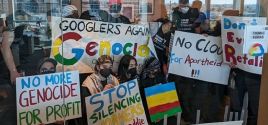President Obama Rolls Back Some Police Militarization... Police Flip Outby Mike MasnickTechdirt May. 20, 2015 |
Popular 
Report: Blinken Sitting On Staff Recommendations to Sanction Israeli Military Units Linked to Killings or Rapes

America Last: House Bill Provides $26B for Israel, $61B for Ukraine and Zero to Secure U.S. Border

Bari Weiss' Free Speech Martyr Uri Berliner Wants FBI and Police to Spy on Pro-Palestine Activists

'Woke' Google Fires 28 Employees Who Protested Gaza Genocide

John Hagee Cheers Israel-Iran Battle as 'Gog and Magog War,' Will Lobby Congress Not to Deescalate
 We've had a bunch of stories lately about the increase in militarized police and what a ridiculous and dangerous idea it is. As we've discussed in the past, much of this came from the Defense Department and its 1033 program, which takes decommissioned military equipment and gives it to police. This results in bizarre situations like the LA School District police having a bunch of grenade launchers. The program is somewhat infamous for its lack of rules, transparency and oversight. So it was great to see President Obama this week issue an executive order that greatly scales back the program. You'll be happy to know that no future LA School Districts will get grenade launchers (though, to be fair, after bad publicity, the school district did give the ones it had received back): Grenade launchers, bayonets, tracked armored vehicles, weaponized aircraft and vehicles, firearms and ammunition of .50-caliber or higher will no longer be provided to state and local police agencies by the federal government under Obama's order.For police departments that already have the now "banned" items, they will have to be returned. You'll notice that one of the biggest symbols that people point to of overly-militarized police -- the MRAP -- is not included in the banned list. There are some other limitations here as well. And a big one, as the guy who literally wrote the book on militarized police, Radley Balko, notes: the 1033 program is no longer the biggest supplier of such things to police: Since 2003, for example, the Department of Homeland Security has been giving grants to police departments around the country to purchase new military-grade gear. That program now dwarfs the 1033 Program. It has also given rise to a cottage industry of companies that build gear in exchange for those DHS checks. Those companies now have a significant lobbying presence in Washington. I suspect that presence will now only grow stronger. So if the Obama administration really wants to roll back police militarization, this program needs reform, too.Still, as Balko also notes, there is still a lot of importance in the symbolism of the move made this week: From what has been reported, this new initiative addresses these concerns as well and seems to indicate that the Obama administration understands and appreciates that the symbolic component of police militarization is just as important as the practical component. I'm uncomfortable with any military vehicles going to local police. Free societies tend to draw a clear line between cops and soldiers. Blurring that line indicates a failure to appreciate its importance. But this initiative is moving toward reestablishing that line, not moving it or further blurring it. Federal programs are pretty difficult to disband, so a blanket ban was probably never in the cards. Conditioning the acceptance of this gear on increased transparency, accountability and a move toward community policing seems like a good compromise. We'll either get less use of this military-issued equipment, or we'll get more and better information about how it's used. Either outcome is progress.Balko gives some additional (fantastic) background on why President Obama made the announcement in Camden, New Jersey -- a city that had serious problems between the local police and the community, and basically figured out a way to restart from scratch (closing down the local police force and letting the county take over) while creating a much stronger community tie between police and the community, rather than the all-too-common adversarial relationship that has grown up in many places (which is often made worse by the militarization). Not surprisingly... there are already loud complaints from police representatives, who complain (misleadingly) about how this move puts them all in danger: The nation's largest police union is fighting back against a White House plan to restrict local police forces' ability to acquire military-style gear, accusing President Barack Obama's task force of politicizing officers' safety.Other police are hilariously arguing that this move will actually increase military presence, because police without this equipment will no longer be able to contain crowds, and thus the National Guard will have to be called in more frequently. Of course, all of that seems to assume that violent protests are the norm, rather than a semi-rare occurrence -- and, it also ignores how militarized police often seem to exacerbate such situations, rather than calm them down. This move doesn't end the militarization of police, but it does take a step in the right direction. As Balko notes, if we believe in a free society, we shouldn't have militarized police. This move is an important step up. Equipment Final Report Final (PDF) |



